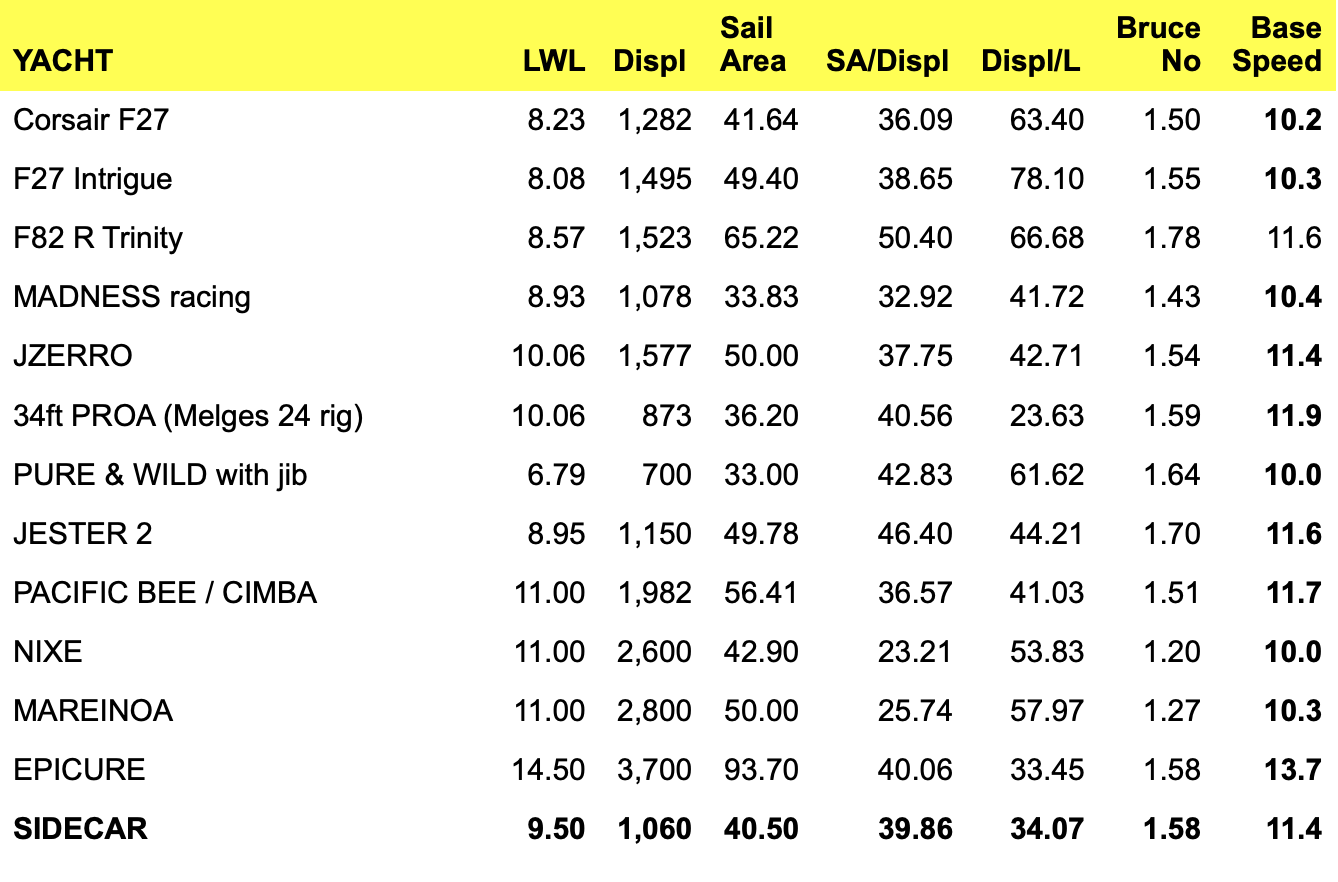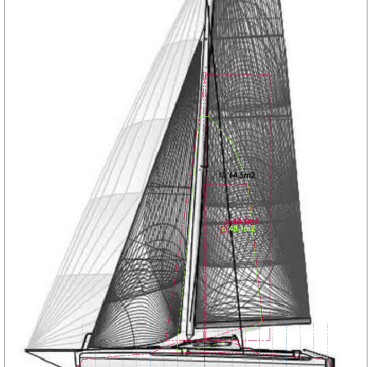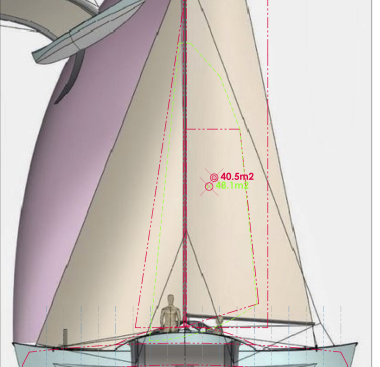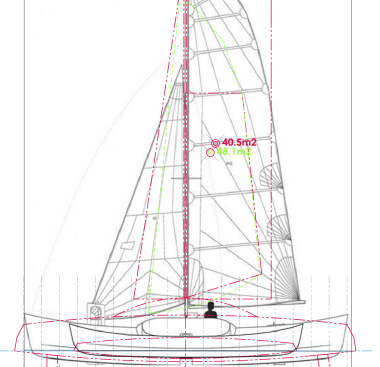Comparative Analysis of Multihulls
Robert Zabukovec, the designer/builder of SIDECAR who’s story was published in the previous article, has kindly agreed to share some of his design methods with us here at Proafile. These are tools that anyone with spreadsheet or CAD software can use. —Editor
Comparative Analysis
Most sailors regard proas as weird and freakish, and a few, the most wonderful thing in sailing. Proas have a mythical fantasy status, but they are just another form of multihull with their own particular advantages, disadvantages and compromises. Most modern proas tend to be updated copies of the traditional types or incorporate features that are far from the norm, so most of the multihull community can’t or won’t relate to them.
And then there has been the totally self defeating debate about which proa type is ‘best’ to add to the general bemusement of the wider sailing community.
It has always been hard to compare how proas relate in terms of performance to other multihulls, because there has been virtually no close up sailing interaction. Proas need to be sailed or raced extensively against the other multihulls and evolve just like other multihulls have, before they can be understood and find an accepted place in multihull society.
So how else to compare different proas with each other and other multihulls without sailing against each other or preparing complex, costly, detailed VPP analysis when there are so many aspects upon which there is little or no performance data on proas, and especially their rigs?
Base Speed
The multihull racing community decided a long time ago that there was no real way of differentiating between the different multihull types, so multihull handicap ratings are largely based on the three fundamental properties of all sailing craft, ie: Effective sailing length, sail area and displacement.
Sidecar’s unmeasured/predicted Offshore Multihull Rule (OMR) rating, single handed is likely to be around 0.861 white sails only, few would understand what that meant relatively speaking, apart from a few keen OMR racers, and even then they only know and can easily compare OMR’s with downwind sails included.
Base Speed is more easily relatable to the wider sailing community.
MOCRA, OMR and Texel rating systems all use fairly similar formulae based on these measured factors to derive an average or “Base Speed”, which is then converted into a time correction factor.
A spread sheet can be set up, inputting the three factors, and calculate the Base Speed and any other ratio you may be interested in, such as Displacement/Length and Sail Area/ Displ or Bruce Number.
Likely top speed will be double Base Speed, and Base Speed also approximates likely top speed upwind in flat water.

Indicative table above based on single handed crew where possible. Best to use white sails only, downwind sails will distort the Base Speed. Try to compare like for like and beware designer optimism and sales talk. If possible get (measured) data on other multihulls from rating websites.
Playing around with these basic parameters on any given boat can also be instructive.
Overlays
For those with CAD drafting ability, another tool is to use images of yachts or aspects you are interested in, rescaled to suit, inserted under your design or a trace of another design for comparison. Areas and centers of effort and lateral resistance can also be added.
If you overlay one design over another properly, to scale, you can compare headroom, freeboard, amas and rigs. Interesting to see for example that the the general rocker lines for Jester, Madness, Seacart 30, many Farrier tris and Sidecar are remarkably similar in character, especially the front half. All arrived at independently without reference to one another. Compare Sidecar’s ama with that of a Seacart 30, and then remember that the Seacart 30 has two of them, and you begin to understand that the weight efficiency of proas is also huge windage and drag efficiency as well, which doesn’t show up in the numbers.
If you have CAD, you can trace a poly line, around any shape or profile of interest which can give areas and girths. Real numbers rather than a visual guess. If you convert those (closed) polylines into “regions” (in AutoCad) you can get the centroid of those traces, which gives you the ability to calculate moments for comparison.
When I was looking into balance problems on Sidecar, it is the underwater hull, appendage and sail area traced profiles which allowed me to quantify the differences between various designs and recognize the trends and outliers.
The same goes for centers of effort for rigs, you can compare the differences between these and the hull appendage CLR’s to see how balanced they are.
Overlays are what you make of them. I use them a lot, mostly out of curiosity…. Again, it is nice to see how Sidecar, or any proa design fits into the multihull world.
For example, if you look at the outline of Sidecar on the Seacart 30:
- Seacart 30, vacuum bagged, autoclaved carbon composite has a Base Speed of ~ 13.0 knots white sails only single handed.
- Sidecar (31) carvel plank timber, home built has a Base Speed of ~ 11.4 knots white sails only single handed.
Could you sail a Seacart 30 single-handed off docks, off moorings or anchor as easily as Sidecar? Not likely. Space and livability down below? Sidecar wins hands down. 88% of the Base Speed for a tiny fraction of the initial build cost.
And then there is this:
Hulls
As it happens they are also both around the same overall weight in rating trim. Vacuum bag and autoclave a Sidecar in carbon composite and you have two choices:
A) Save the weight, say 300 kg, and keep everything else the same: Base Speed: 12.3 knots.
B) Keep it the same weight and rig, make the main hull longer, bearing in mind that Sidecar’s bare finished 31 ft timber vaka also weighs around 300 kilos. 12.3m LWL gets you the same Base Speed of 13.0 knots. Or play the numbers outlined above, adding length and/or more sail area, for whatever combination feels best for your purposes.
Rigs
To achieve its ~ 13 knot Base Speed, the Seacart 30 needs 60% more sail area on a 60% taller and 3 times heavier mast than for Sidecar to achieve its ~ 11.4 knot Base Speed. The difference in mast weight alone is the rough equivalent of 17 house bricks attached mid mast. You know where most of the money is in a sail boat? Spend the cash difference to make Sidecar longer again with more sail?
It is much easier to see and understand these kinds of things when you look at overlays. Enjoy overlaying and playing the numbers to find out.
Base Speed is further explained here.
All images courtesy and copyright Robert Zabukovec.






I only understood a fraction of this but still very interesting.
What’s the measurement for the general bow rockers of the proas
you’ve discussed? Thank you!